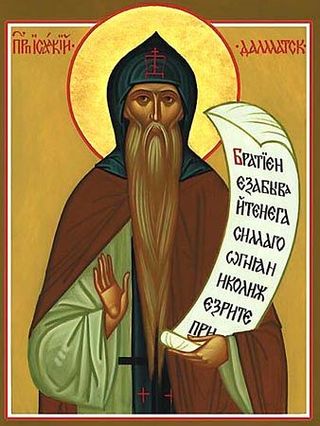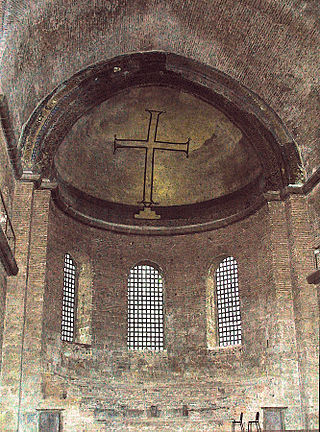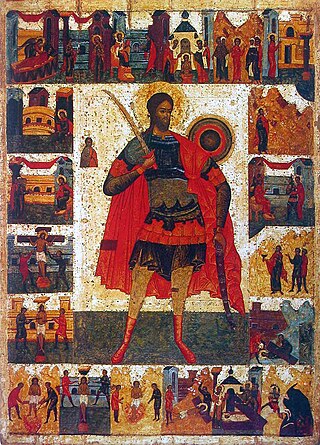The 360s decade ran from January 1, 360, to December 31, 369.

Maximus the Confessor, also spelled Maximos, otherwise known as Maximus the Theologian and Maximus of Constantinople, was a Christian monk, theologian, and scholar.

Saint Jacob of Nisibis, also known as Saint Jacob of Mygdonia, Saint Jacob the Great, and Saint James of Nisibis, was a hermit, a grazer and the Bishop of Nisibis until his death.

Saint Isaac the Confessor, also Isaacius or Isaakios, founder of the Dalmatian Monastery in Constantinople, was a Christian monk who is honored as a saint and confessor. He is sometimes referred to as Isaac the Dalmatian, not because he came from Dalmatia, but because of the monastery which he founded.

April 2 - Eastern Orthodox liturgical calendar - April 4

April 5 — Eastern Orthodox liturgical calendar — April 7

May 12 - Eastern Orthodox Church calendar - May 14

May 13 - Eastern Orthodox Church calendar - May 15

May 27 - Eastern Orthodox Church calendar - May 29
There are two individuals known as Basil the Confessor ; one was a monk and the other Bishop of Parium.

Saint Nicetas of Medikion or Nicetas the Confessor, who is commemorated on 3 April, was a monk who opposed Byzantine Iconoclasm.

February 17 - Eastern Orthodox liturgical calendar - February 19
Nicetas or Nikitas or Niketas (Νικήτας) is a Greek given name, meaning "victorious one" . The veneration of martyr saint Nicetas the Goth in the medieval period gave rise to the Slavic forms: Nikita, Mykyta and Mikita

The Byzantine Iconoclasm were two periods in the history of the Byzantine Empire when the use of religious images or icons was opposed by religious and imperial authorities within the Ecumenical Patriarchate and the temporal imperial hierarchy. The First Iconoclasm, as it is sometimes called, occurred between about 726 and 787, while the Second Iconoclasm occurred between 814 and 842. According to the traditional view, Byzantine Iconoclasm was started by a ban on religious images promulgated by the Byzantine Emperor Leo III the Isaurian, and continued under his successors. It was accompanied by widespread destruction of religious images and persecution of supporters of the veneration of images. The Papacy remained firmly in support of the use of religious images throughout the period, and the whole episode widened the growing divergence between the Byzantine and Carolingian traditions in what was still a unified European Church, as well as facilitating the reduction or removal of Byzantine political control over parts of the Italian Peninsula.

Eastern Christian monasticism is the life followed by monks and nuns of the Eastern Orthodox Church, Oriental Orthodoxy, the Church of the East and some Eastern Catholic Churches.
The title of New Martyr or Neomartyr is conferred in some denominations of Christianity to distinguish more recent martyrs and confessors from the old martyrs of the persecution in the Roman Empire. Originally and typically, it refers to victims of Islamic persecution.
Michael of Synnada or Michael the Confessor was a metropolitan bishop of Synnada from 784/7 to 815. He represented Byzantium in diplomatic missions to Harun al-Rashid and Charlemagne. He was exiled by Emperor Leo V the Armenian because of his opposition to iconoclasm, and died on 23 May 826. He is honoured as a saint by the Eastern Orthodox and Roman Catholic churches, his feast day is May 23.

Nicetas is a Christian martyr of the 4th century, venerated particularly in the Eastern Orthodox Church. His feastday is 15 September. Nicetas was of Gothic origin, living during the 4th century AD. His life spanned the years of Emperor Constantine the Great's sole rule. He belonged to the upper social class of his people. Nicetas was instructed in Christianity by Theophilus of Gothia, a converted bishop, between 325 and 341 AD.
Saint Nicetas the Patrician was a Byzantine monk and a fervent opponent of Byzantine Iconoclasm. He is usually identified with Nicetas Monomachos, a eunuch official and general from Paphlagonia active at the turn of the 9th century.
This is a timeline of the presence of Eastern Orthodoxy in Greece from 717 to 1204. The history of Greece traditionally encompasses the study of the Greek people, the areas they ruled historically, as well as the territory now composing the modern state of Greece.